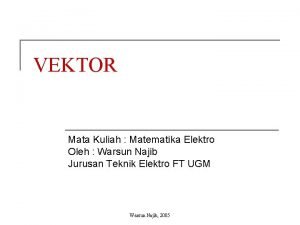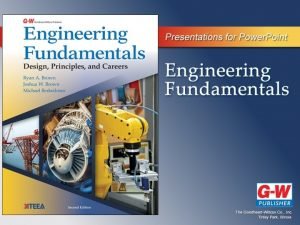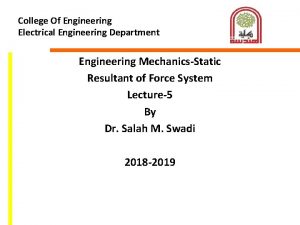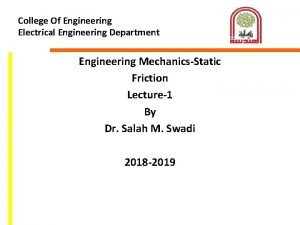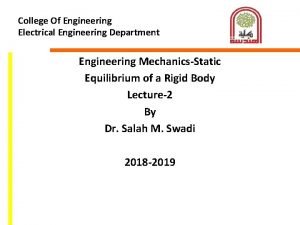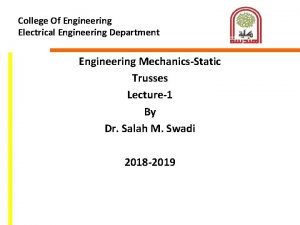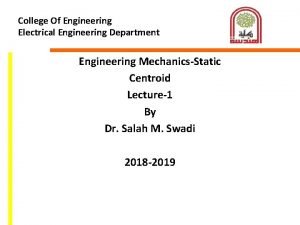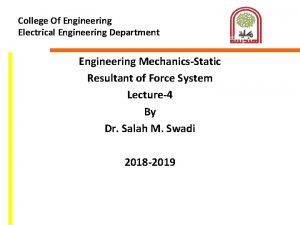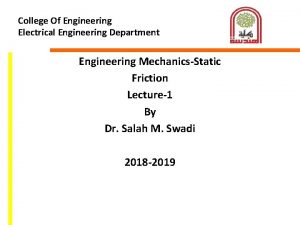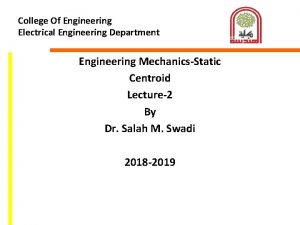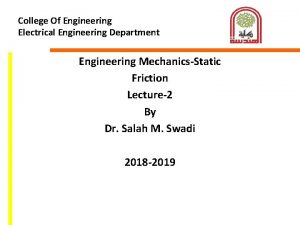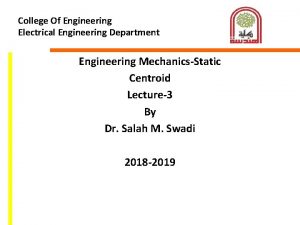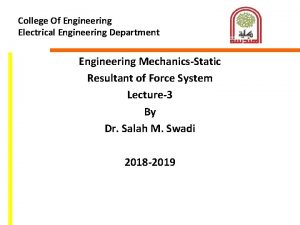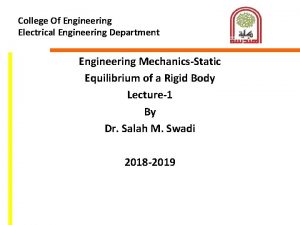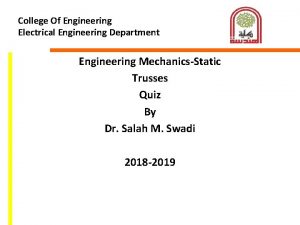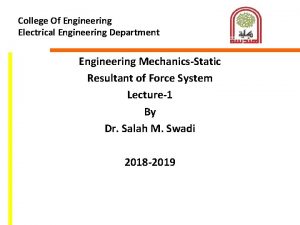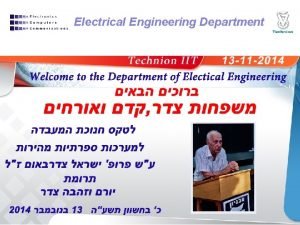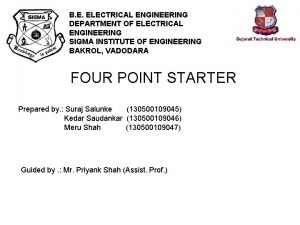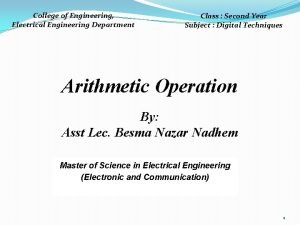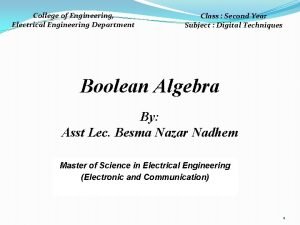College Of Engineering Electrical Engineering Department Engineering MechanicsStatic




















- Slides: 20

College Of Engineering Electrical Engineering Department Engineering Mechanics-Static Trusses Lecture-2 By Dr. Salah M. Swadi 2018 -2019

6. 4 The Method of Sections • • • Used to determine the loadings within a body If a body is in equilibrium, any part of the body is in equilibrium To find forces within members, an imaginary section is used to cut each member into 2 and expose each internal force as external

6. 4 The Method of Sections • • Consider the truss and section a-a as shown Member forces are equal and opposite to those acting on the other part – Newton’s Law

6. 4 The Method of Sections Procedure for Analysis Free-Body Diagram • Decide the section of the truss • Determine the truss’s external reactions • Use equilibrium equations to solve member forces at the cut session • Draw FBD of the sectioned truss which has the least number of forces acting on it • Find the sense of an unknown member force

6. 4 The Method of Sections Procedure for Analysis Equations of Equilibrium • Summed moments about a point • Find the 3 rd unknown force from moment equation

Example 6. 5 Determine the force in members GE, GC, and BC of the truss. Indicate whether the members are in tension or compression.

Solution • Choose section a-a since it cuts through the three members • Draw FBD of the entire truss

Solution • Draw FBD for the section portion

6. 5 Space Trusses • • • Consists of members joined together at their ends to form 3 D structure The simplest space truss is a tetrahedron Additional members would be redundant in supporting force P

6. 5 Space Trusses Assumptions for Design • • Members of a space truss is treated as 2 force members provided the external loading is at the joints When weight of the member is considered, apply it as a vertical force, half of its magnitude applied at each end of the member Method of Joints • • Solve ∑Fx = 0, ∑Fy = 0, ∑Fz = 0 at each joint Force analysis has at least 1 unknown force and 3 unknown forces

6. 5 Space Trusses Method of Sections • When imaginary section is passes through a truss it must satisfied ∑Fx = 0, ∑Fy = 0, ∑Fz = 0 ∑Mx = 0, ∑My = 0, ∑Mz = 0 • By proper selection, the unknown forces can be determined using a single equilibrium equation

Example 6. 8 Determine the forces acting in the members of the space truss. Indicate whether the members are in tension or compression.

Solution For Joint A,

Solution For Joint B, To show,

6. 6 Frames and Machines • • • Composed of pin-connected multi-force members Frames are stationary Apply equations of equilibrium to each member to determine the unknown forces

6. 6 Frames and Machines Free-Body Diagram • Isolate each part by drawing its outlined shape – show all forces and couple moments act on the part – identify each known and unknown force and couple moment – indicate any dimension – apply equations of equilibrium – assumed sense of unknown force or moment – draw FBD

Example 6. 9 For the frame, draw the free-body diagram of (a) each member, (b) the pin at B and (c) the two members connected together.

Solution Part (a) • BA and BC are not two-force • AB is subjected to the resultant forces from the pins

Solution Part (b) • Pin at B is subjected to two forces, force of the member BC and AB on the pin • For equilibrium, forces and respective components must be equal but opposite • Bx and By shown equal and opposite on members AB

Solution Part (c) • Bx and By are not shown as they form equal but opposite internal forces • Unknown force at A and C must act in the same sense • Couple moment M is used to find reactions at A and C
 Electrical engineering department
Electrical engineering department Tum department of electrical and computer engineering
Tum department of electrical and computer engineering Ucla electrical engineering department
Ucla electrical engineering department Pasadena city college police department
Pasadena city college police department Vector electrical engineering
Vector electrical engineering Gwu electrical engineering
Gwu electrical engineering Tel aviv university electrical engineering
Tel aviv university electrical engineering Electrical engineering northwestern
Electrical engineering northwestern Klipsch school of electrical and computer engineering
Klipsch school of electrical and computer engineering Umd ece faculty
Umd ece faculty Electrical installation estimating and costing
Electrical installation estimating and costing Electrical engineering environmental issues
Electrical engineering environmental issues Wpi ece flowchart
Wpi ece flowchart Electrical engineering presentation
Electrical engineering presentation Kfupm ee faculty
Kfupm ee faculty Big data in electrical engineering
Big data in electrical engineering Define electrical engineering
Define electrical engineering Basic electrical engineering kulshreshtha
Basic electrical engineering kulshreshtha University of belgrade school of electrical engineering
University of belgrade school of electrical engineering Electrical engineering notation
Electrical engineering notation Bus electrical engineering
Bus electrical engineering




